Holidays and festive seasons are the perfect opportunities to increase sales and gain more customers. That’s why this article is about how to crush your next seasonal marketing campaign in four easy steps.
You’ll learn the best practices for planning, launching, and managing seasonal promotions. And as a bonus, we’re including some tips to help you set your seasonal popups up for success.
But first, let’s discuss what are seasonal marketing campaigns exactly.
What is a seasonal campaign?
A seasonal marketing campaign is like a marketing dance with the calendar.
It’s all about tapping into those specific times of the year when people’s interests, needs, and purchasing habits change.
Whether it’s Valentine’s Day, Back-to-School season, the spooky vibes of Halloween, or Black Friday, there’s always something going on that your business can leverage.
Why is seasonal marketing important?
Why should you care about seasonal marketing anyway? There are a couple of reasons.
1. Riding the wave of consumer interest
Whether it’s planning for summer vacations, stocking up on winter essentials, or searching for the perfect gift, consumers are tuned into what’s happening around them.
By aligning your marketing strategy with these seasonal shifts, you’re basically saying, “Hey, we get you!”
It’s like speaking their language, but instead of words, you’re using irresistible deals, timely promotions, and themed content to catch their attention.
2. Creating a sense of urgency
Ever heard of FOMO? Well, seasonal marketing plays right into that psychological trigger.
When people know that a product or an offer is only available for a limited time, they’re more likely to act fast. This can help to boost sales.
3. Standing out in a sea of sameness
Let’s face it, the world of marketing can be a crowded place. But when you jump on the seasonal sales bandwagon, you have a golden opportunity to stand out from the competition.
Think of it as your chance to deck the halls (or your website) with festive cheer, making your brand more memorable and engaging in the process.
4. Building customer relationships
Seasonal marketing isn’t just about making sales; it’s also about building connections with your target audience.
When you show up during key moments throughout the year, you’re not just a faceless brand trying to sell stuff – you’re a friend, a trusted advisor, and a go-to source for all things seasonal.
How to run killer seasonal campaigns in 4 easy steps
If you’d like to optimize your marketing strategy for the best results all year round, follow these tips. Let’s start with the most important step—getting the word out.
Step 1: Spread the word with a pre-event campaign before your launch
Don’t wait until launch day to tell the world about your big event.
Create a pre-event list-building campaign to generate awareness before the time.
A good pre-event campaign acts as a teaser before your upcoming event. It’s also the perfect opportunity to build your email or SMS list—and you’ll use that list to stay in touch with subscribers once your seasonal event goes live.
Here’s our two-part process for making your pre-event launch a smooth one.
Part 1: Target visitors with a popup
Draw attention to your important events with a pre-event popup that notifies visitors of your launch date.
Consider incorporating an event marketing platform into your toolkit for preparing the event as a great place to start.
You don’t want to tell them everything here—just give a glimpse of what customers can expect. You can add:
- The length of your seasonal marketing campaign.
- How much money customers can save (“Up to 80% off!”).
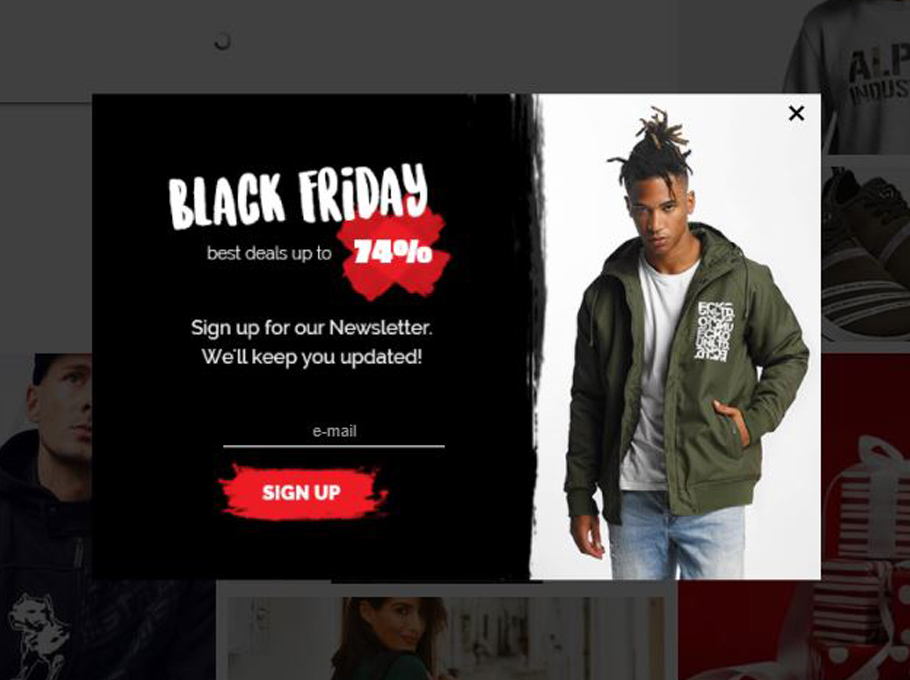
Only message visitors who are genuinely interested in your products. For example, you can target people who’ve spent at least 30 seconds on your site and visited two or more pages.
We suggest launching your pre-event popup at least a week before your seasonal campaign goes live. This gives you enough time to build a good list, and it gives visitors enough time to prepare for your sale.
Quick note: Feel free to kick off your pre-event campaign earlier. One week before launch is the latest recommended time for a campaign teaser, but you can start earlier if you like. If you’re planning a huge seasonal campaign, consider running your pre-event popups a month before launching the real thing.
Part 2: Spread the word on social media
You probably have social media followers who’d be interested in your seasonal promotion if they knew about it—but they don’t visit your site regularly enough to see it.
Reconnect with them by promoting your pre-event campaign over social media.
Gymshark does this every time before they launch a seasonal event to increase awareness and create excitement around the sale.
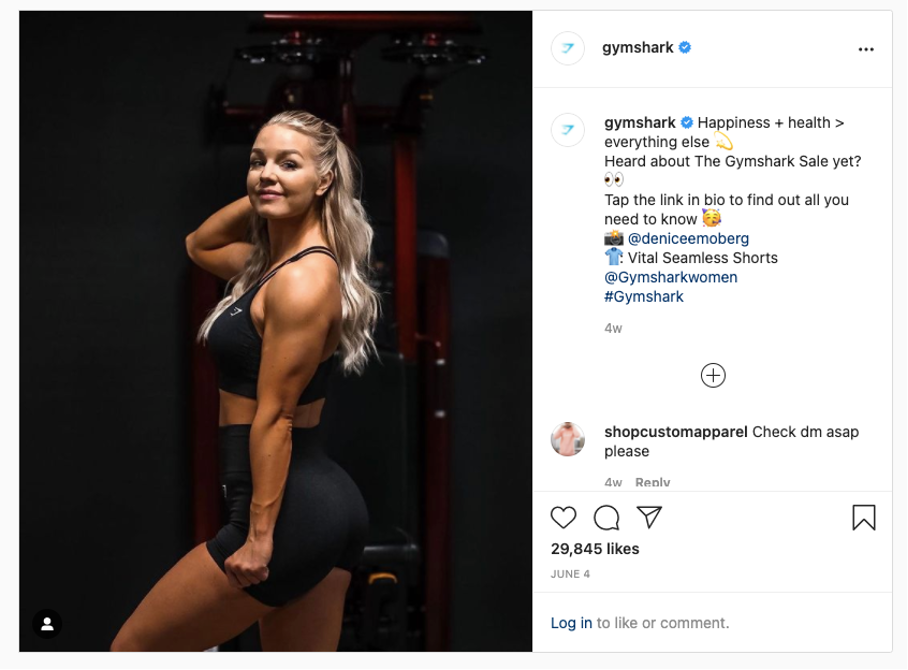
They didn’t just post once, either. They created several pre-event posts in the days leading up to their campaign launch.

Use the same method so your followers don’t forget about your seasonal campaign.
Try highlighting different products in every post to tease followers with the items included in your sales event.
If you’d like to learn more about Gymshark’s marketing strategy, check out this video:
Step 2: Remind customers about your seasonal marketing campaigns
Your pre-event campaign gave you a list of interested subscribers eager to participate in your seasonal event. Now, send those potential customers reminders when your seasonal event goes live.
You can make your emails enticing by promoting your best-selling products to customers. Try using urgency and FOMO (Fear Of Missing Out) to keep them motivated.
Here are some ideas you can use to increase email conversions:
- Add a countdown timer to your email. Popular email marketing platforms like Klaviyo, Mailchimp, and Campaign Monitor offer this feature—and they integrate with OptiMonk.
- Use phrases like “only 1 day left” to remind customers that your deals are ending soon.
- Notify customers when you’re running low on popular items. Seeing a sentence like “only 5 items left” next to a product will motivate customers to buy from you.
There isn’t a magic number when it comes to deciding how many emails to send. It depends on the length of your campaign.
Make a timeline when sending multiple emails throughout your seasonal event:
- Send your first reminder once your campaign is live. Tell customers to take advantage of your exclusive offers.
- Send several follow-up emails while your campaign is ongoing. This is where you’ll use the urgency and FOMO tactics we covered above.
- Include a final email the hour before your campaign ends, telling customers that they have one last chance to save money.
Here’s how Ted Baker kicked off their summer sale.

The purpose of this email is to tell customers that they’re running a 30% off sale for summer. They kept it short and sweet.
Now let’s look at one of their follow-up emails.

See how they create a sense of urgency in the follow-up email.
The headline under the main picture now says “in high demand” to let the customer know items are selling out quickly. And they drive this point home even further in the description by using phrases like “pieces are flying out” and “if you don’t, somebody else will.”
They also include pictures of their best-selling products, so customers can see what is being snatched up.
Step 3: Use influencers to promote your seasonal campaign
If you’re already working with influencers, use your seasonal campaign as an opportunity to collaborate.
They can reach customers outside of your network by promoting your campaign on social media—giving you new visitors to engage with.
This is how Gymshark used influencers to promote their sales event:

Notice how she promoted Gymshark’s event at the end of her post.
People follow Whitney Simmons for workout tips and other valuable information. She gives her followers the content they crave, then casually promotes Gymshark at the very end.
This approach works because you don’t target followers with boring advertisements they’ll end up ignoring. You give them content that brings value, then conclude the post with a quick promotion. That’s the magic of influencer marketing.
You might be thinking Gymshark is a big brand that’s known for their influencer marketing strategy—and you’re a small company without a huge marketing budget. That doesn’t mean you can’t enjoy similar results.
We talked about how you can find affordable influencers to grow your reach in our ColourPop marketing breakdown. Take a look.
Step 4: Target your visitors with personalized onsite messages
We looked at how you can use email and social media to promote your seasonal event. Now, see how you can use OptiMonk to target website visitors with popups for your campaign.
Check out our Template Library for themes and templates. We offer a wide range of themes for holidays and special events, including:
- Christmas
- Halloween
- Black Friday
- Summer Sales
- Back to School
- New Year’s Eve
- Valentine’s Day
- And more
Choose a template that complements your seasonal campaign or create your own from scratch using our drag-and-drop editor.

Now for the important part—configuring your popup to target the right people. Fortunately, OptiMonk makes this ridiculously easy.

Set your campaign trigger to “on exit-intent” to target visitors when they try to leave your site. This lets you deliver an on-site message without disrupting their browsing experience.
You also need to choose who sees your popups so you can target the right people (and don’t annoy everyone else). Here’s how you can do it.

Exclude everyone who engaged with your pre-event campaign.
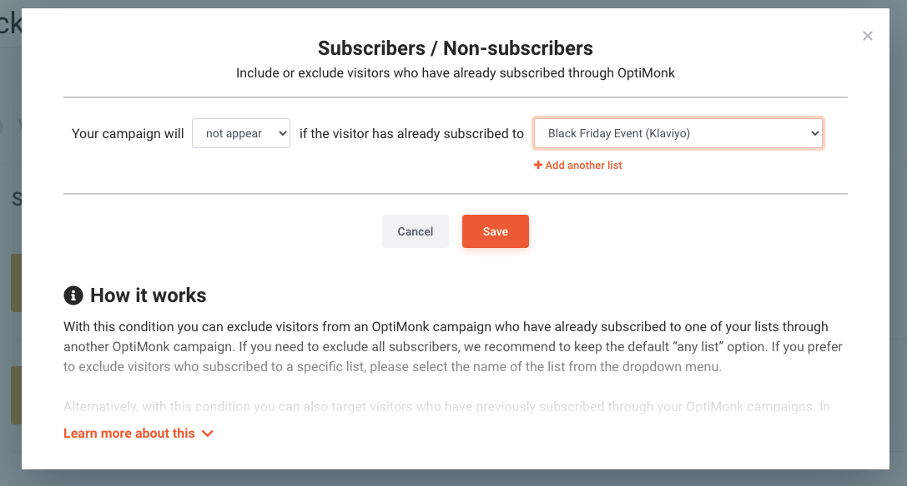
And exclude everyone who’s already a subscriber to your seasonal campaign mailing list.
These are the people you advertised to during your pre-event, your social media posts, and your email marketing campaigns. They already know about your seasonal event, so you shouldn’t send them popups unnecessarily.
Use Facebook ads to retarget visitors who knew about your event but didn’t purchase anything. This will bring them back into the sales funnel without annoying them with irrelevant popups.
Remember, popups are only effective when you enhance your customer’s onsite experience with messages that bring them value. Let’s look at how OptiMonk is great for creating those campaigns that customers value.
3 expert tips for running better popup campaigns
We looked at how to plan and launch your seasonal campaign. Now we’re going to show you how to maximize your conversion rates through popups, personalization and good targeting.
These are best practices that will help you with your seasonal events and your year-round campaigns.
Let’s get started.
Tip 1: Target the right visitors
Sending generic onsite messages to every visitor may earn you a few conversions and one-time sales, but it doesn’t bring customers back. You gain lifetime customers when you deliver relevant messages that improve their shopping experience.
Let’s look at how AVON ensured their Children’s Day promotions made it to the right visitors.

AVON didn’t want to interrupt customers who aren’t interested in their Children’s Day campaign, so they targeted visitors browsing their kids’ category.
These visitors are shopping for children, so they’re more likely to be interested in discounts on children’s products.
OptiMonk is great for targeting specific audience on your site. Use AVON’s approach by going to your campaign settings page…
- Choose “Select who should see the popup” from the menu options.
- Click “+ Add new condition” and choose “Current Page / URL” from the available options.
- Enter the URL of the pages you want to display your popup on.

AVON chose to display their message on every page that had “kids-care” in the URL because those pages are part of their children’s section.
Now they can target people interested in their product without sending irrelevant messages to the rest of their visitors.
Tip 2: Increase sales by adding genuine urgency to your campaign
Remember when we talked about the value of urgency? Well, OptiMonk makes it easy for you to use urgency without being deceptive.
Use the template below to add a sticky bar to your website that notifies visitors of your limited-time sale without interrupting them.
You can set the schedule of your sticky bar or popup, so it only runs while your seasonal campaign is active.
Here’s an example of a sticky bar scheduled for a Christmas campaign.
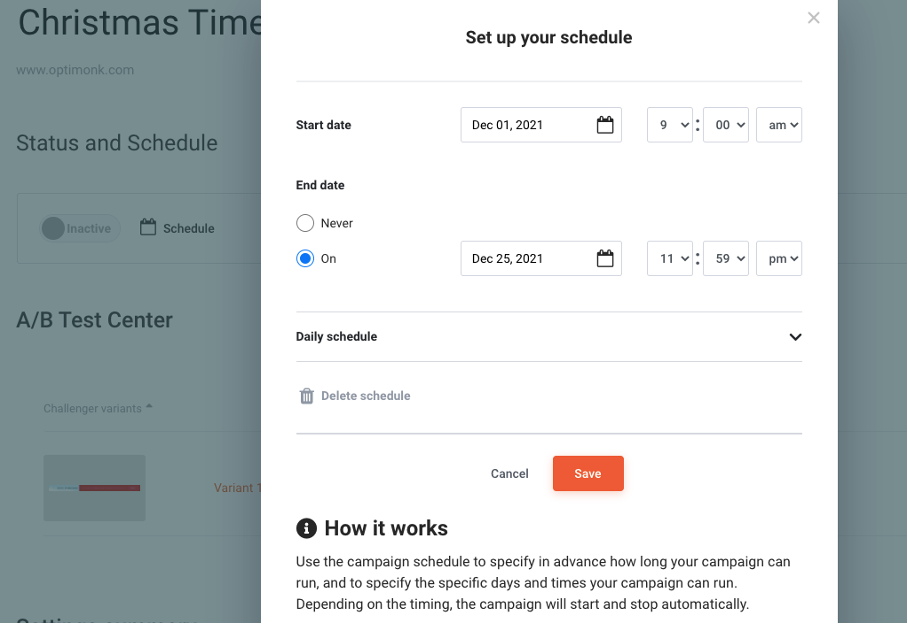
Running a deal for a limited time is a great way to motivate customers to buy from you. And seasonal campaigns work especially well because urgency is already baked into them.
Customers know that your event will run for a set time period—so there’s no need to use “fake urgency” like deceptive countdown timers to drive one-time sales. Instead, base your campaign on creating a sense of urgency.
When visitors notice vendors are running the same one-day-only discount for weeks at a time, they won’t feel like they’re getting a deal––they’ll feel like they’re being manipulated. This causes storeowners to lose out on repeat sales.
Tip 3: Gamify your messages
Gamified popups are a fun way to target your visitors, and they can give you a massive lift in conversions.
The Body Shop’s conversion rates jumped to 67.06% when they ran a gamified popup for their Christmas campaign.
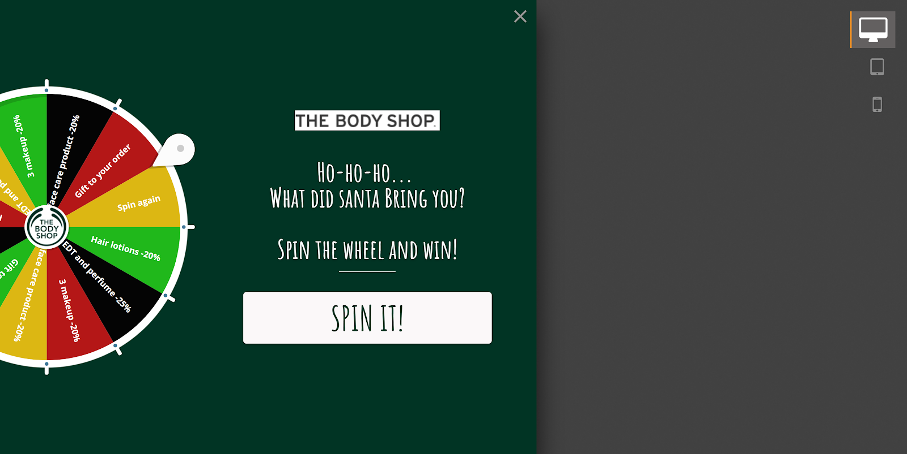
Want to know why? Because gamified popups add excitement to your onsite message campaigns by showing visitors something different than your everyday popup or banner.
Try OptiMonk’s ready-to-use lucky wheel templates to gamify your site in minutes. We offer a variety of holiday-themed lucky wheels to get your visitors in a festive spirit.
Put your seasonal marketing campaign strategy to work
Now that we’ve looked at how you can successfully launch seasonal promotions to increase sales, there’s only one thing left to do—start planning.
Create a promotional calendar with all the seasonal opportunities, then follow the steps in this post to make your next summer event or Black Friday clearance sale a hit.
Make sure to register for a free OptiMonk account once you’re ready to put your campaign in motion. OptiMonk makes it incredibly easy to grow your email list, target customers with special offers, and generate hype around your seasonal and year-round campaigns.












